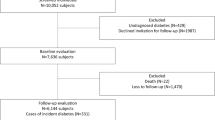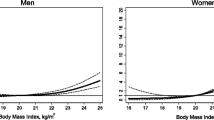Abstract
Aim
To investigate the risk of type 2 diabetes (T2DM) among the combinations of BMI categories and metabolic syndrome in Asian Indians.
Materials and methods
Individuals from the Chennai Urban Rural Epidemiology Study cohort (n = 1,368), free of diabetes at baseline were stratified by BMI and metabolic health as metabolically healthy non-obese (MHNO), metabolically healthy obese (MHO), metabolically obese non-obese (MONO) and metabolically obese obese (MOO). Phenotypic obesity was defined as BMI ≥ 25 kg/m2 and metabolic obesity as presence of any two of the metabolic abnormalities: hyperglycemia, high blood pressure, high triglyceridemia or low HDL cholesterol. Hazard ratios for progression to diabetes were estimated using Cox proportional hazard regression.
Results
During median 9.1 years of follow-up, incident cases of diabetes were highest among MOO–45.1%, followed by MONO–41.3%, MHO–27.1% and MHNO–15.9%. Incidence rates of diabetes among MOO, MONO, MHO and MHNO were 57.8, 50.9, 30.4 and 18.1 per 1000 person years, respectively. Hazard ratio for diabetes development were 1.71 in MHO, 2.87 in MONO, and 3.39 in MOO compared with MHNO.
Conclusions
Increased BMI and metabolic risk factor clustering independently contribute to the increased risk of T2DM in obese individuals. Screening for metabolic abnormalities should be performed routinely in clinic to identify high-risk individuals and institute appropriate preventive measures.


Similar content being viewed by others
Abbreviations
- BMI:
-
Body Mass Index
- T2DM:
-
Type 2 diabetes
- CURES:
-
Chennai Urban Rural Epidemiology Study
References
WHO (2018) – Fact sheet–Obesity and overweight. Updated February 2018. https://www.who.int/en/news-room/fact-sheets/detail/obesity-and-overweight Accessed 20 July 2020.
Kelly T, Yang W, Chen CS, Reynolds K, He J (2008) Global burden of obesity in 2005 and projections to 2030. Int J Obes (Lond) 32(9):1431–1437
International diabetes federation (2019) IDF diabetes atlas, 9th edn. Belgium, Brussels
Vazquez G, Duval S, Jacobs DR Jr, Silventoinen K (2007) Comparison of body mass index, waist circumference, and waist/hip ratio in predicting incident diabetes: a meta-analysis. Epidemiol Rev 29(1):115–128
Eckel RH, Kahn SE, Ferrannini E, Goldfine AB, Nathan DM, Schwartz MW, Smith RJ, Smith SR (2011) Obesity and type 2 diabetes: what can be unified and what needs to be individualized? J Clin Endocrinol Metab 96(6):1654–1663
Brochu M, Tchernof A, Dionne IJ, Sites CK, Eltabbakh GH, Sims EA, Poehlman ET (2001) What are the physical characteristics associated with a normal metabolic profile despite a high level of obesity in postmenopausal women? J Clin Endocrinol Metab 86(3):1020–1025
Karelis AD, Faraj M, Bastard JP, St-Pierre DH, Brochu M, Prudhomme D, Rabasa-Lhoret R (2005) The metabolically healthy but obese individual presents a favorable inflammation profile. J Clin Endocrinol Metab 90(7):4145–4150
Ruderman NB, Schneider SH, Berchtold P (1981) The, “metabolically-obese”, normal-weight individual. Am J Clin Nutr 34(8):1617–1621
Ruderman N, Chisholm D, Pi-Sunyer X, Schneider S (1998) The metabolically obese, normal-weight individual revisited. Diabetes 47(5):699–713
Karelis AD, St-Pierre DH, Conus F, Rabasa-Lhoret R, Poehlman ET (2004) Metabolic and body composition factors in subgroups of obesity: what do we know? J Clin Endocrinol Metab 89(6):2569–2575
Phillips CM (2013) Metabolically healthy obesity: definitions, determinants and clinical implications. Rev Endocr Metab Disord 14(3):219–227
Stefan N, Häring HU, Hu FB, Schulze MB (2013) Metabolically healthy obesity: epidemiology, mechanisms, and clinical implications. Lancet Diabetes Endocrinol 1(2):152–162
Appleton SL, Seaborn CJ, Visvanathan R (2013) North west adelaide health study team diabetes and cardiovascular disease outcomes in the metabolically healthy obese phenotype: a cohort study. Diabetes Care 36(8):2388–2394
Meigs JB, Wilson PW, Fox CS et al (2006) Body mass index, metabolic syndrome, and risk of type 2 diabetes or cardiovascular disease. J Clin Endocrinol Metab 91(8):2906–2912
Hinnouho GM, Czernichow S, Dugravot A et al (2015) Metabolically healthy obesity and the risk of cardiovascular disease and type 2 diabetes: the Whitehall II cohort study. Eur Heart J 36(9):551–559
Ärnlöv J, Sundström J, Ingelsson E, Lind L (2011) Impact of BMI and the metabolic syndrome on the risk of diabetes in middle-aged men. Diabetes Care 34(1):61–65
Twig G, Afek A, Derazne E et al (2014) Diabetes risk among overweight and obese metabolically healthy young adults. Diabetes Care 37(11):2989–2995
Aung K, Lorenzo C, Hinojosa MA, Haffner SM (2014) Risk of developing diabetes and cardiovascular disease in metabolically unhealthy normal-weight and metabolically healthy obese individuals. J Clin Endocrinol Metab 99(2):462–468
Jung CH, Lee MJ, Kang YM et al (2015) The risk of incident type 2 diabetes in a Korean metabolically healthy obese population: the role of systemic inflammation. J Clin Endocrinol Metab 100(3):934–941
Hwang LC, Bai CH, Sun CA, Chen CJ (2012) Prevalence of metabolically healthy obesity and its impacts on incidences of hypertension, diabetes and the metabolic syndrome in Taiwan. Asia Pac J Clin Nutr 21(2):227
Bell JA, Kivimaki M, Hamer M (2014) Metabolically healthy obesity and risk of incident type 2 diabetes: a meta-analysis of prospective cohort studies. Obes Rev 15(6):504–515
Rhee EJ, Lee MK, Kim JD (2014) Metabolic health is a more important determinant for diabetes development than simple obesity: a 4-year retrospective longitudinal study. PLoS ONE 9(5):98369
Deepa M, Pradeepa R, Rema M et al (2003) The chennai urban rural epidemiology study (CURES)-study design and methodology (urban component) (CURES-I). J Assoc Physicians India 51:863–870
American Diabetes Association (1997) Report of the expert committee on the diagnosis and classification of diabetes mellitus. Diabetes Care 20:1183–1197
Inoue S, Zimmet P, Catersen I (2000) Steering Committee of the WHO Western Pacific Region, IASO & IOTF. The Asia-Pacific perspective: redefining obesity and its treatment: Health Communication Australia Pty.
Alberti KGMM, Eckel RH, Grundy SM et al (2009) Harmonizing the metabolic syndrome: a joint interim statement of the international diabetes federation task force on epidemiology and prevention; national heart, lung, and blood institute; American heart association; world heart federation; international atherosclerosis society; and international association for the study of obesity. Circulation 120(16):1640–1645
American Diabetes Association (2014) Diagnosis and classification of diabetes mellitus. Diabetes Care 37(Supplement 1):S81-90
Succurro E, Marini MA, Frontoni S et al (2008) Insulin secretion in metabolically obese, but normal weight, and in metabolically healthy but obese individuals. Obesity 16(8):1881–1886
Neeland IJ, Turer AT, Ayers CR et al (2012) Dysfunctional adiposity and the risk of prediabetes and type 2 diabetes in obese adults. JAMA 308(11):1150–1159
Latifi SM, Karandish M, Shahbazian H, Cheraghian B, Moradi M (2017) Prevalence of Metabolically Healthy Obesity (MHO) and its relation with incidence of metabolic syndrome, hypertension and type 2 Diabetes amongst individuals aged over 20 years in Ahvaz: a 5 Year cohort Study (2009–2014). Diabetes Metab Syndr Clin Res Rev 11:S1037-1040
Acknowledgments
The authors thank the staff of Dr. Mohan’s Diabetes Specialities Centre, Chennai and the epidemiology team of the Madras Diabetes Research Foundation for the fieldwork and all the participants who took part in the study. Future risk of diabetes among Indians with metabolic and phenotypic obesity—Results from the ten-year follow-up of the Chennai Urban Rural Epidemiology Study (CURES–158)
Funding
No funding was received for this work.
Author information
Authors and Affiliations
Contributions
VM conceived the study and involved in execution of the fieldwork, wrote parts of the manuscript and revised all drafts of the article. HN wrote the draft of the manuscript. CSSR and MD were involved in the execution of the fieldwork and wrote the parts of the manuscript. RMA provided scientific inputs and revised the drafts of the manuscript. RU and RGP gave valuable comments and suggestions for the writing of the article. GU helped in the fieldwork to collect data. UV and KK did all the statistical analyses of the data. VM, RMA and CSSR are the guarantors of this work and, as such, had full access to all the data in the study and take responsibility for the integrity of the data and the accuracy of the data analysis. All authors have read and approved the final manuscript.
Corresponding author
Ethics declarations
Conflict of interests
None of the authors has any potential conflicts of interest relevant to the article.
Ethics approval
The study protocol was approved by the Institutional Ethical committee.
Informed consent
Participants provided written informed consent before inclusion in the study.
Additional information
Communicated by Massimo Federici .
Publisher's Note
Springer Nature remains neutral with regard to jurisdictional claims in published maps and institutional affiliations.
Supplementary Information
Below is the link to the electronic supplementary material.
Rights and permissions
About this article
Cite this article
Natarajan, H., Shanthi Rani, C., Krishna Kumar, D. et al. Future risk of diabetes among Indians with metabolic and phenotypic obesity: Results from the 10-year follow-up of the Chennai Urban Rural Epidemiology Study (CURES–158). Acta Diabetol 58, 1051–1058 (2021). https://doi.org/10.1007/s00592-021-01698-7
Received:
Accepted:
Published:
Issue Date:
DOI: https://doi.org/10.1007/s00592-021-01698-7




